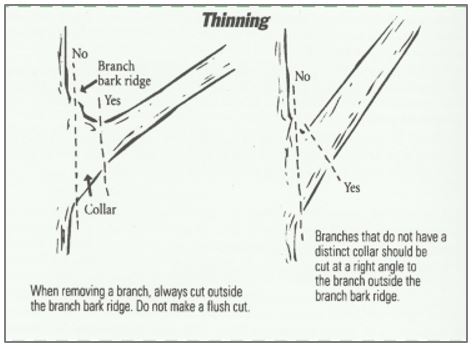Why Do We Prune?
- To remove broken, dead, or diseased branches to maintain healthy trees;
- To improve the structure of younger trees;
- To control growth near or over homes, buildings, and other structures;
- For aesthetic purposes.
Pruning large trees or trees near power lines requires the attention of a professional arborist. For tips on finding an arborist, visit our Find an Arborist page. If you decide to prune the trees yourself, here are some helpful tips:
- Prune all dead or dying branches regularly to improve the tree's health and avoid future problems.
- Prune to maintain the desired shape or size and to keep the tree attractive.
- Prune crossing or rubbing branches to prevent further damage.
- Prune to increase or reduce the density of the tree.
- Generally, trees should be thinned to produce a more open plant allowing light and air to penetrate the canopy interior. If denser growth is desired, heading back is required.
Whether you prune your trees yourself or hire an arborist, make sure to disinfect all pruning equipment before and during pruning. Disinfection with methyl hydrate helps to prevent the accidental spread of disease to other trees.
The Perfect Pruning Cut
The stem or trunk point where a branch is attached is called the branch ridge and collar. This point is also where the "sealing tissue" is found. If a branch is pruned properly, the tree will seal over the wound by itself. It's important not to cut too close to this tissue or too far away — doing so will result in improper sealing and leave the wound open to pests and disease. Generally, pruning cuts should be made at a 45-degree angle to avoid damaging the branch ridge and collar.

Branches that do not have a distinct collar should be cut at a right angle to branch outside the branch bark ridge.
Types of Pruning
Crown Thinning
Thinning is removing whole branches where they attach to the next major branch or the trunk of the tree. This process is used to remove weak, aged, dead, diseased, or undesirable branches. Avoid removing large branches that will take away more than 25 per cent of the tree's total growth.
Heading Back
Heading or cutting back the terminal end of a stem or branch to a bud or lateral branch can help maintain a tree's shape or height. Use the "one-third formula" when heading back. Never remove more than one-third of a live branch. Heading cuts may also be necessary to correct storm-damaged branches when trying to salvage as much of a limb/branch as possible.
Large Limb Removal
Removing heavy limbs, 7 cm (3 in) in diameter or greater, requires certain precautions to avoid tearing bark from the tree trunk. The first cut into the branch is made on the lower side, about 30 cm (12 in) from the trunk. The second cut is made on the branch's upper side, about 35 cm (14 in) from the trunk. Finally, the remaining stub is cut off, while keeping the branch ridge and collar intact. This method ensures a clean cut that will seal over properly.
Treating Wounds
Ensuring a proper pruning cut will speed the sealing process of the tree. Trees have their own defence mechanisms and will seal the pruning wound on their own, so long as the reproductive cells in the ridge and collar are not damaged. Treating wounds is not recommended. In the past, trees were painted for aesthetic reasons, but painting will not speed the healing process. Household paints and wood preservatives are toxic and should not be used.

